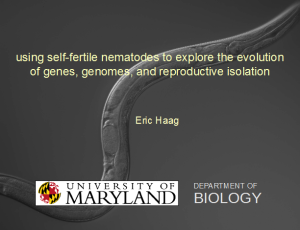
NWDB Conference - Slides from Eric Haag and Update
Earlier I reported on the informative talks and posters at the Northwest Developmental Biology conference -
Reporting on the Northwest Developmental Biology Conference (1)
Reporting on the Northwest Developmental Biology Conference (2)

Eric Haag presented at the conference on genome deletion of various members of _Caenorhabditis _ species. This topic may interest our readers since many of them work on genome assembly. When Eric first noticed the smaller genome sizes for some of his hermaphrodite samples, the genome center he was working with thought the observation was from assembly glitch or other non-biological issues. However, he spent time to work through the difference and determine that the difference was indeed of biological origin.
He was kind enough to send us his slides and we attach them here. They contain most parts of his talk except for a subset of unpublished results.

Eric also added a number of corrections to our previous discussion of his work, which we present below verbatim.
1. It’s important to understand that I discussed quite a number of different species in my talk, all of which are the genus Caenorhabditis, but only one of which was C.
elegans.
2. The deletions I discussed happened in the recent evolutionary history of C.
elegans, C. briggsae, and other less-studied species, all united (we think) only by
having adopted a self-fertile hermaphrodite mode of sex. Philosophically I’m not
sure when to say the deletions occurred with respect to taxonomy (i.e. was the
pre-hermaphroditic C. elegans ancestor already “C. elegans” or something else? But
hopefully you get the point: C. elegans, as conventionally defined as an extant
taxon, is already shrunken.
3. The deletions shouldn’t be characterized as “programmed,” because that implies
precisely regulated and highly predictable loss, and we don’t have evidence for
that. What we do have is evidence for loss that is predictable in quantity and to a
lesser extent by broad chromosomal domain (i.e. more in the ends, less in the
middle). These features are probably due to the interaction of stochastic
mutational events (which may have certain biases) and the landscape of genetic
redundancy at the time the lineage switches to self-fertility.
The genome shrinkage stuff was part of a set of vignettes related to the
consequences of becoming a self-fertile hermaphrodite. I mentioned genome shrinkage
(the issue above), deregulation of sex-biased gene expression, and increased
vulnerability to harm by mating with obligately outcrossing relatives. I summarized
that half of the talk by suggesting that these consequences eventually slam the door
on returning to an outcrossing mode of reproduction, and make selfing species more
subject to extinction when the environment changes.
I can also summarize the first part of the talk as being about how independently
evolved hermaphroditic species, C. elegans and C. briggsae, have both repeated and
idiosyncratic aspects to the way they regulate the key trait that makes that
possible–XX sperm production. That was based to a large extent on work from my lab,
but also with major contributions from the groups of Judith Kimble, Tim Schedl, Ron
Ellis, and David Pilgrim (who was also a meeting co-organizer).